Cement Pastes with Hygroscopic Polymeric Additions for Potential Building Applications
Abstract
1. Introduction
2. Materials and Methods
2.1. Materials
2.2. Characterization Methods and Instruments
3. Results and Discussion
3.1. Rheological Observations
3.2. Porosity Distribution
3.3. SEM Observations
3.4. Mechanical Tests
3.5. Thermal Measurements
4. Conclusions
- Hygroscopic polymeric additions make cement paste less workable than CS, because they rapidly absorb water, detracting from its rheological role.
- The porosity evolution was investigated at different curing stages; mercury intrusion porosimetry (MIP) has been used for investigating pores’ evolution during aging and after a heat treatment at 200 °C. The pore size distribution appeared to be bimodal when sodium polyacrylate was added, as already reported in the literature [20]. The presence of polyamide fibers made the pore size distribution bimodal. This distribution was maintained during aging for up to 28 days. NY/SA-PA was the only sample that maintained the bimodal distribution even after the heat treatment.
- Under five cycles of loading–unloading shear stress, the samples containing polyamide fibers showed significant visco-plastic deformation until pores cracked at the tip and connected with adjacent pores to form a micro-fracture surface. The micro-fracture surface extended, forming macroscopic cracks, which could eventually lead to shear failure of the cement paste consolidation body along the interface layer.
- Cement pastes are useful for heat-storing walls or energy-efficient insulation. In the first case, the product ka−0.5, where k is the thermal conductivity and a is the thermal diffusivity, must be maximized, whereas a0.5k−1 must be maximized in the second case. The cement paste containing sodium polyacrylate (SA-PA sample) maximized both values (9.2 102 m−2 K−1 s0.5 W and 1.1 10−3 m2 K s−0.5 W−1, respectively) due to its high diffusivity. After thermal treatment at 200 °C, SA-PA showed the highest value for heat-storing (6.3 102 m−2 K−1 s0.5W), whereas the sample containing both nylon fibers and sodium polyacrylate (Ny/SA-PA sample) showed the highest values for energy-efficient insulation (2.6 10−3 m2 Ks−0.5 W−1) due to the concurrent presence of macro- and micropores.
- Further studies will be necessary to confirm the trends in pore distribution and the effects on thermal and mechanical properties. Future research should also consider other cementitious materials to increase the predictive indications for designing large-scale concrete, plaster, coatings, or mortar.
Author Contributions
Funding
Data Availability Statement
Acknowledgments
Conflicts of Interest
References
- Longhi, F.; Surico, F. Effect of a Crystallizing Admixtures on Concrete Properties: Italian Concrete Days. In Proceedings of the Conference on Italian Concrete Days, Naples, Italy, 14–17 April 2021; Springer: Berlin, Germany, 2018; pp. 312–324. [Google Scholar]
- Coppola, L.; Coffetti, D.; Crotti, E. Innovative carboxylic acid waterproofing admixture for self-healing watertight concrete. Const. Build. Mater. 2018, 171, 817–824. [Google Scholar] [CrossRef]
- Cui, L.; Cahyadi, J.H. Permeability and pore structure of OPC paste. Cem. Conc. Res. 2001, 31, 277–282. [Google Scholar] [CrossRef]
- Muhammad, N.Z.; Keyvanfar, A.; Majid, M.Z.A.; Shafaghat, A.; Mirza, J. Waterproof performance of concrete: A critical review on implemented approaches. Constr. Build. Mater. 2015, 101, 80–90. [Google Scholar] [CrossRef]
- Wang, W.; Wang, S.; Yao, D.; Wang, X.; Yu, X.; Zhang, Y. Fabrication of all dimensional superhydrophobic mortar with enhanced waterproof ability and freeze-thaw resistance. Constr. Build. Mater. 2020, 238, 117626. [Google Scholar] [CrossRef]
- Li, C.; Wu, M.; Chen, Q.; Jiang, Z. Chemical and mineralogical alterations of concrete subjected to chemical attacks in complex underground tunnel environments during 20–36 years. Cem. Concr. Compos. 2018, 86, 139–159. [Google Scholar] [CrossRef]
- Li, J.; Jin, Q.; Zhang, W.; Li, C.; Monteiro, P.J.M. Microstructure and durability performance of sustainable cementitious composites containing high-volume regenerative biosilica. Resour. Conserv. Recycl. 2022, 178, 106038. [Google Scholar] [CrossRef]
- Di Maggio, R.; Dirè, S.; Callone, E.; Bergamonti, L.; Lottici, P.P.; Albatici, R.; Rigon, R.; Ataollahi, N. Super-adsorbent polyacrylate under swelling in water for passive solar control of building envelope. SN Appl. Sci. 2020, 2, 45. [Google Scholar] [CrossRef]
- Jensen, O.M.; Hansen, P.F. Water-entrained cement-based materials: I. Principles and theoretical background. Cem. Concr. Res. 2001, 31, 647–654. [Google Scholar] [CrossRef]
- Hu, J.; Stroeven, P. Local porosity analysis of pore structure in cement paste. Cem. Conc. Res. 2005, 35, 233–242. [Google Scholar] [CrossRef]
- Reinhardt, H.W.; Gaber, K. From pore size distribution to an equivalent pore size of cement mortar. Mater. Struct. 1990, 23, 3–15. [Google Scholar] [CrossRef]
- Guo, Y.; Zhang, P.; Ding, H.; Le, C. Experimental Study on the Permeability of SAP Modified Concrete. Materials 2020, 13, 3368. [Google Scholar] [CrossRef]
- Rose, D.A. Water movement in unsaturated porous materials. RILEM Bull. 1965, 2912, 119–124. [Google Scholar]
- Fu, J.-X.; Wang, K.; Wang, J. Internal pore evolution and early hydration characterization of fly ash cement backfill. J. Build. Eng. 2023, 72, 106716. [Google Scholar] [CrossRef]
- Stazi, F.; Corinaldesi, V.; Capotondo, Y.; Porcarelli, I.; Di Perna, C.; D’Orazio, M. Effect of pore modulating additives-sepiolite and colloidal nano silica-on physical, mechanical and durability properties of lime-based renders. Mater. Struct. 2022, 55, 123. [Google Scholar] [CrossRef]
- Isebaert, A.; De Boever, W.; Descamps, F.; Dils, J.; Dumon, M.; De Schutter, G.; Van Ranst, E.; Cnudde, V.; Van Parys, L. Pore-related properties of natural hydraulic lime mortars: An experimental study. Mater. Struct. 2016, 49, 2767–2780. [Google Scholar] [CrossRef]
- Liu, X.; Chen, X.; Shahrestani, M. Optimization of Insulation Thickness of External Walls of Residential Buildings in Hot Summer and Cold Winter Zone of China. Sustainability 2020, 12, 1574. [Google Scholar] [CrossRef]
- Mercuri, M.; Vailati, M.; Gregori, A. Lime-based mortar reinforced with randomly oriented polyvinyl-alcohol (PVA) fibers for strengthening historical masonry structures. Dev. Built Environ. 2023, 14, 100152. [Google Scholar] [CrossRef]
- Zhang, X.; Du, M.; Fang, H.; Shi, M.; Zhang, C.; Wang, F. Polymer-modified cement mortars: Their enhanced properties; applications; prospects, and challenges. Constr. Build. Mater. 2021, 299, 124290. [Google Scholar] [CrossRef]
- Cotini, O.; Di Maggio, R.; Tonelli, D.; Nascimben, R.; Ataollahi, N. Porosity of a fast-setting mortar with crystallization admixture and effect of a SA-PA modification. Materials 2022, 15, 1542. [Google Scholar] [CrossRef]
- Li, J.; Zhang, W.; Xu, K.; Monteiro, P.J. Fibrillar calcium silicate hydrate seeds from hydrated tricalcium silicate lower cement demand. Cem. Concr. Res. 2020, 137, 106195. [Google Scholar] [CrossRef]
- Yu, Y.G.; Angel, R.J.; Ross, N.L. Pressure impact on the structure, elasticity, and electron density distribution of CaSi2O5. Phys. Rev. B Condens. Matter Mater. Phys. 2013, 87, 184112. [Google Scholar] [CrossRef]
- Schoenitz, M.; Navrotsky, A.; Ross, N. Enthalpy of formation of CaSi2O5, a quenched high-pressure phase with pentacoordinate silicon. Phys. Chem. Miner. 2001, 1, 57–60. [Google Scholar] [CrossRef]
- Rostásy, F.; Weiß, R.; Wiedemann, G. Changes of pore structure of cement mortars due to temperature. Cem. Concr. Res. 1980, 10, 157–164. [Google Scholar] [CrossRef]
- Wang, S.; Abdulridha, A.; Naito, C.; Quiel, S.; Suleiman, M.; Romero, C.; Neti, S. Enhancement of conventional concrete mix designs for sensible thermal energy storage applications. J. Energy Storage 2023, 61, 106735. [Google Scholar] [CrossRef]
- McNeill, I.; Sadeghi, S. Thermal Stability and Degradation Mechanisms of Poly(Acrylic Acid) and its Salts: Part 2 Sodium and Potassium Salts. Polym. Degrad. Stab. 1990, 30, 213–230. [Google Scholar] [CrossRef]
- Aslani, F.; Jowkarmeimandi, R. Stress-strain model for concrete under cyclic loading. Mag. Concr. Res. 2012, 64, 673–685. [Google Scholar] [CrossRef]
- Kumar, D.; Alam, M.; Zou, P.X.W.; Sanjayan, J.G.; Memon, R.A. Comparative analysis of building insulation material properties and performance. Renew. Sustain. Energy Rev. 2020, 131, 110038. [Google Scholar] [CrossRef]
- Abu-Jdayil, B.; Mourad, A.-H.; Hittini, W.; Hassan, M.; Hameedi, S. Traditional, state-of-the-art and renewable thermal building insulation materials: An overview. Constr. Build. Mater. 2019, 214, 709–735. [Google Scholar] [CrossRef]
- Hill, C.; Norton, A.; Dibdiakova, J. A comparison of the environmental impacts of different categories of insulation materials. Energy Build. 2018, 162, 12–20. [Google Scholar] [CrossRef]
- D’Orazio, M.; Maracchini, G. An experimental investigation on the indoor hygrothermal environment of a reinforced-EPS based temporary housing solution. Energy Build. 2019, 204, 109500. [Google Scholar] [CrossRef]
- di Filippo, R.; Possidente, L.; Tondini, N.; Bursi, O.S. Quantitative integration of fire risk with life cycle analysis of building: The case of thermal insulation. J. Build. Eng. 2023, 76, 107124. [Google Scholar] [CrossRef]
- Maracchini, G.; D’Orazio, M. Improving the livability of lightweight emergency architectures: A numerical investigation on a novel reinforced-EPS based construction system. Build. Environ. 2022, 208, 108601. [Google Scholar] [CrossRef]
- Posani, M.; Veiga, R.; Freitas, V. Post-Insulating traditional massive walls in Southern Europe: A moderate thermal resistance can be more effective than you think. Energy Build. 2023, 295, 113299. [Google Scholar] [CrossRef]
- Ozger, O.B.; Girardi, F.; Giannuzzi, G.; Salomoni, V.; Majorana, C.; Fambri, L.; Baldassino, N.; Di Maggio, R. Effect of nylon fibers on mechanical and thermal properties of hardened concrete for energy storage systems. Mater. Des. 2013, 51, 989–997. [Google Scholar] [CrossRef]
- Cook, R.A.; Hover, K.C. Mercury porosimetry of hardened cement pastes. Cem. Conc. Res. 1999, 29, 933–943. [Google Scholar] [CrossRef]
- Zhou, J.; Ye, G.; van Breugel, K. Characterization of pore structure in cement-based materials using pressurization–depressurization cycling mercury intrusion porosimetry. Cem. Conc. Res. 2010, 40, 1120–1128. [Google Scholar] [CrossRef]
- Lange, D.A.; Jennings, H.M.; Surenda, S.P. Image analysis techniques for characterization of pore structure of cement-based materials. Cem. Conc. Res. 1994, 24, 841–853. [Google Scholar] [CrossRef]
- Rouquerol, J.; Avnir, D.; Fairbridge, C.W.; Everett, D.H.; Haynes, J.H.; Pernicone, N.; Ramsay, J.D.F.; Sing, K.S.W.; Unger, K.K. Recommendations For The Characterization Of Porous Solids (Technical Report). Pure Appl. Chern. 1994, 66, 1739–1758. [Google Scholar] [CrossRef]
- Nurazuwa, M.; Munadrah; Irmawaty, R.; Muhiddin, A. Compressive strength and microstructure of self-compacting concrete with nylon fiber substitution. IOP Conf. Ser. Earth Environ. Sci. 2022, 1117, 012016. [Google Scholar] [CrossRef]
- Shalchy, F.; Rahbar, N. Nanostructural characteristics and interfacial properties of polymer fibers in cement matrix. ACS Appl. Mater. Interfaces 2015, 7, 17278–17286. [Google Scholar] [CrossRef]
- Jenkins, M.G.; Lara-Curzio, E.; Ashbaugh, N.E. Thermal and Mechanical Test Methods and Behavior of Continuous-Fiber Ceramic Composites; ASTM International: West Conshohocken, PA, USA, 1997; Volume 1309. [Google Scholar]
- Ashby, M.F. Materials Selection in Mechanical Design, 3rd ed.; Butterworth-Heinemann: Oxford, UK, 2005. [Google Scholar]
- Girardi, F.; Giannuzzi, G.; Mazzei, D.; Salomoni, V.; Majorana, C.; Di Maggio, R. Recycled additions for improving the thermal conductivity of concrete in preparing energy storage systems. Constr. Build. Mater. 2017, 135, 565–579. [Google Scholar] [CrossRef]
- Ali, S.I.A.; Lublo, E. Effect of elevated temperature on the magnetite and quartz concrete at different w/c ratios as nuclear shielding concretes. Nucl. Mater. Energy 2022, 33, 101234. [Google Scholar]
- Zhang, X.; Liu, W.; Cao, M.; Zhang, S.; Hou, J. Performances of heat-insulating concrete doped with straw fibers for use in tunnels. Buildings 2023, 13, 818. [Google Scholar] [CrossRef]
- Gencel, O.; Harja, M.; Sarı, A.; Hekimog, G.; Ustaog, A.; Sutcu, M.; Erdogmus, E.; Kaplan, G.; Bayraktar, O.Y. Development, characterization, and performance analysis of shape-stabilized phase change material included-geopolymer for passive thermal management of buildings. Int. J. Energy Res. 2022, 46, 21841–21855. [Google Scholar] [CrossRef]
- Charai, M.; Mezrhab, A.; Moga, L.; Karkri, M. Hygrothermal, mechanical and durability assessment of vegetable concrete mixes made with alfa fibers for structural and thermal insulating applications. Constr. Build. Mater. 2022, 335, 127518. [Google Scholar] [CrossRef]
- Jia, H.; Cui, B.; Niu, G.; Chen, J.; Yang, Y.; Wang, Q.; Tang, C. Experimental and mechanism study on the impermeability and thermal insulation of foam concrete regulated by nano-silica and fluorine-free foam. J. Build. Eng. 2023, 64, 105675. [Google Scholar] [CrossRef]
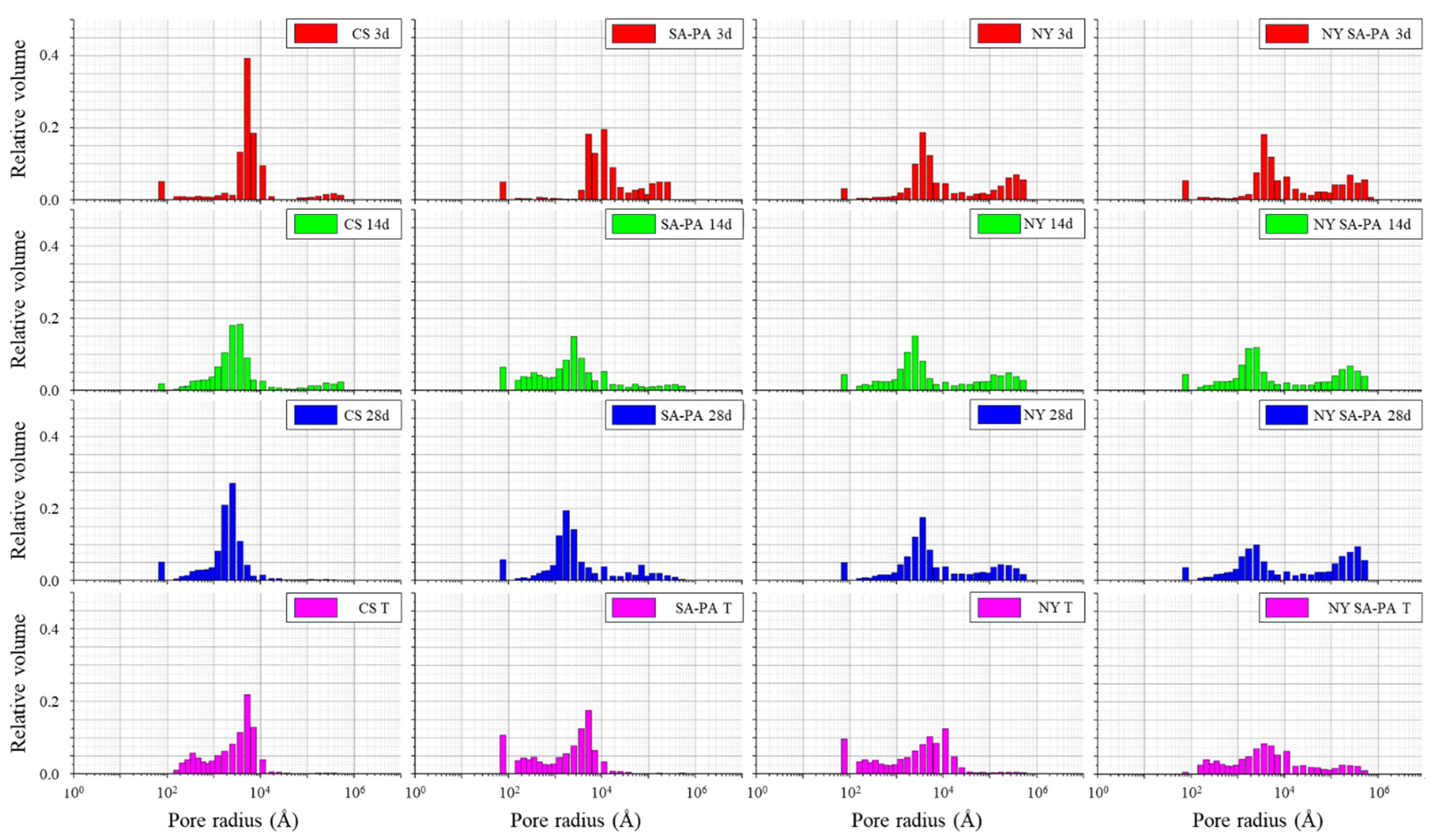


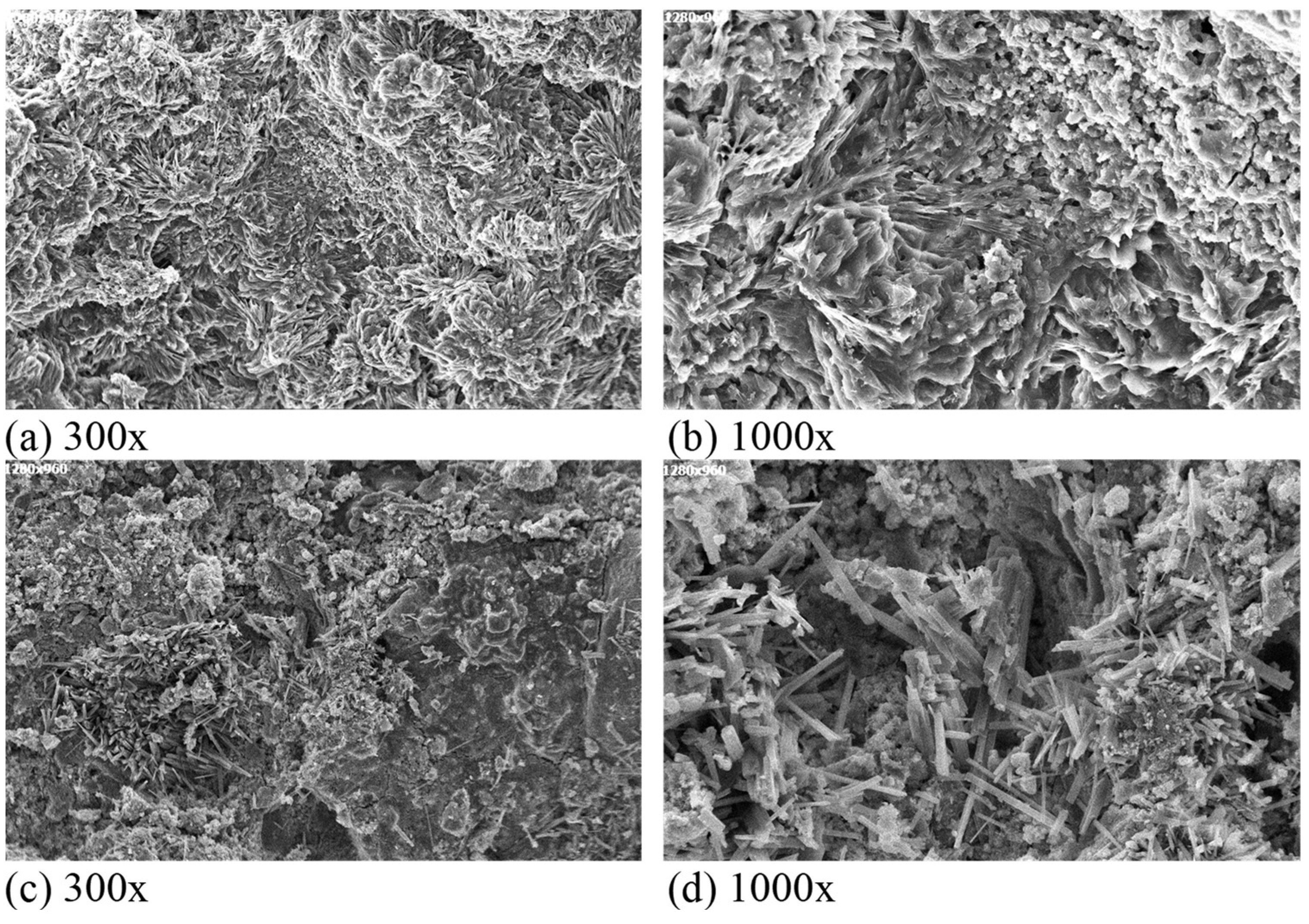
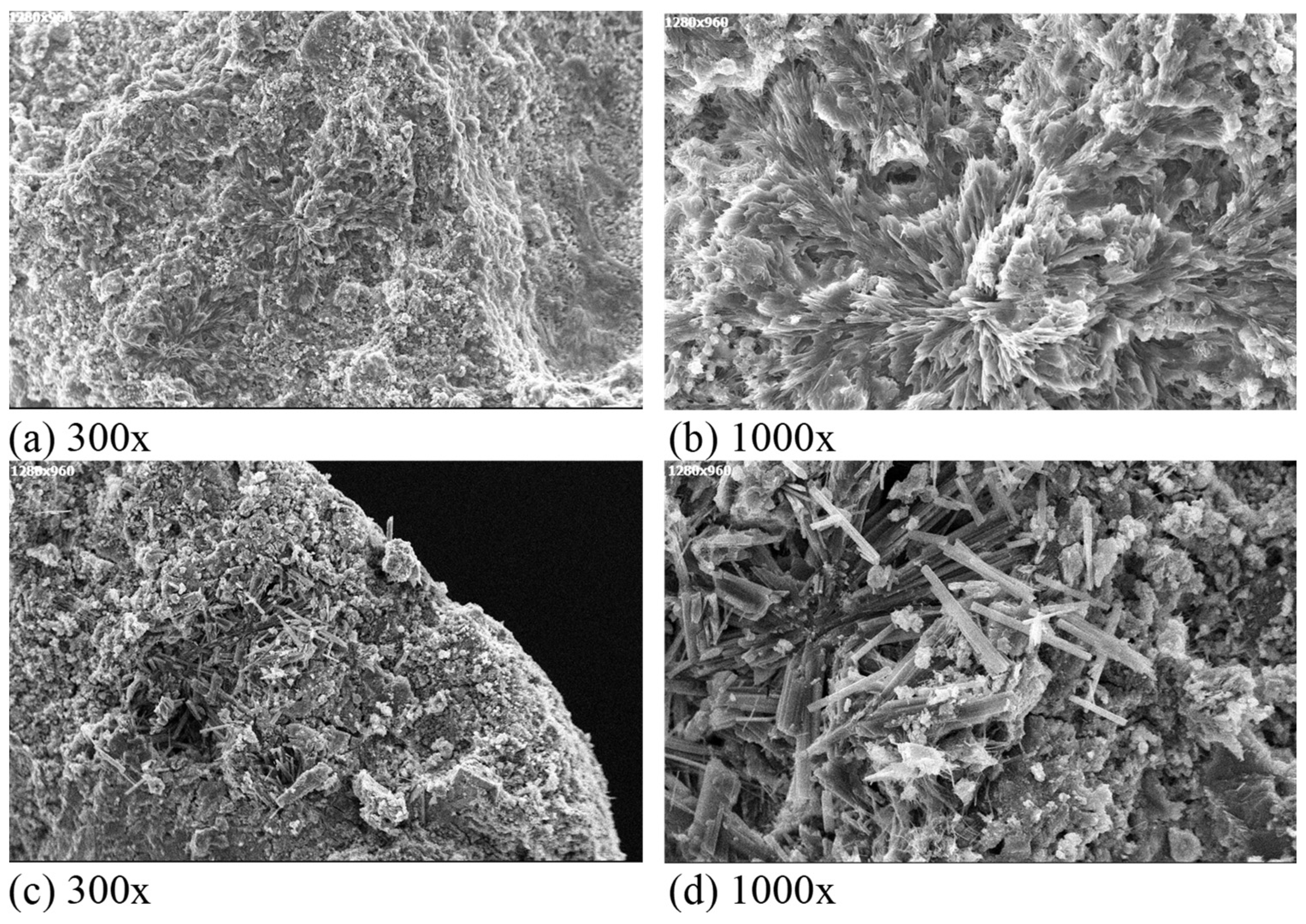
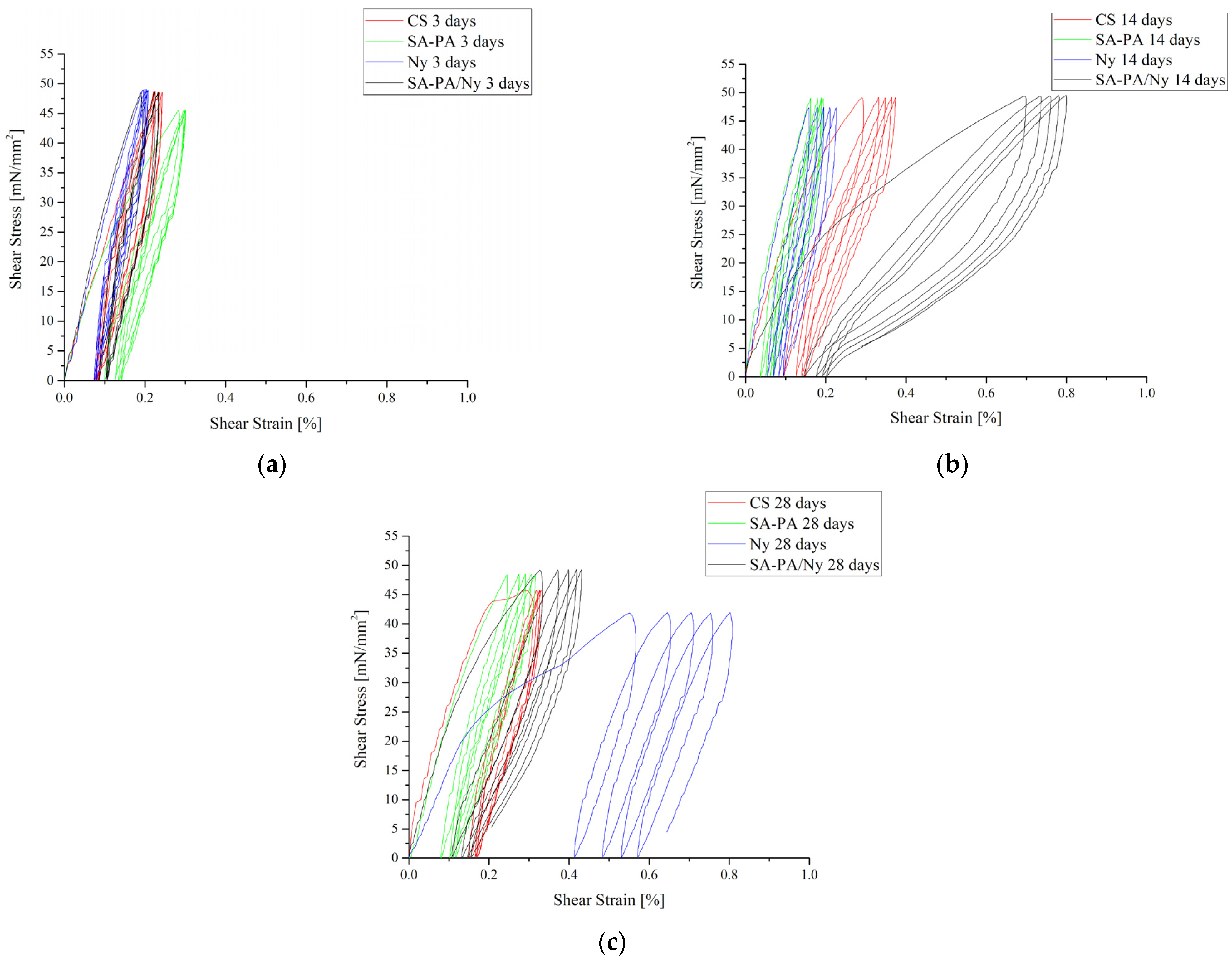
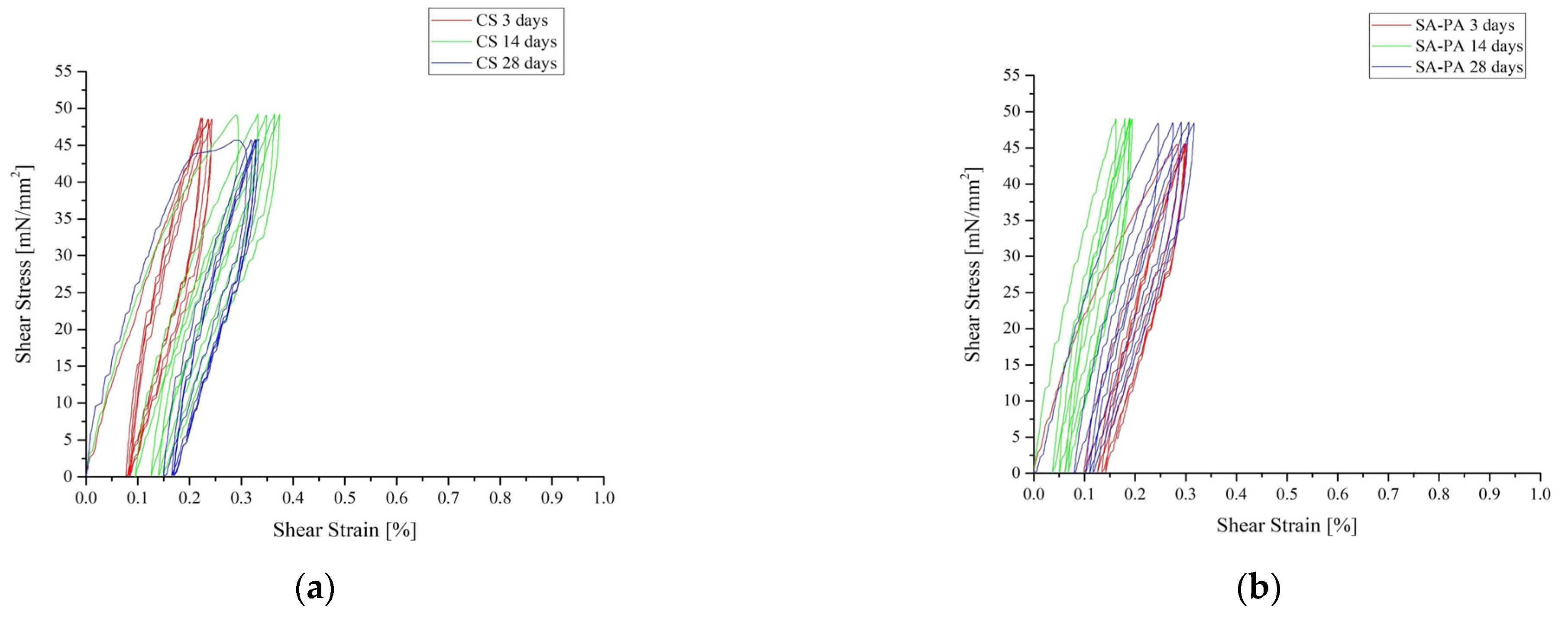
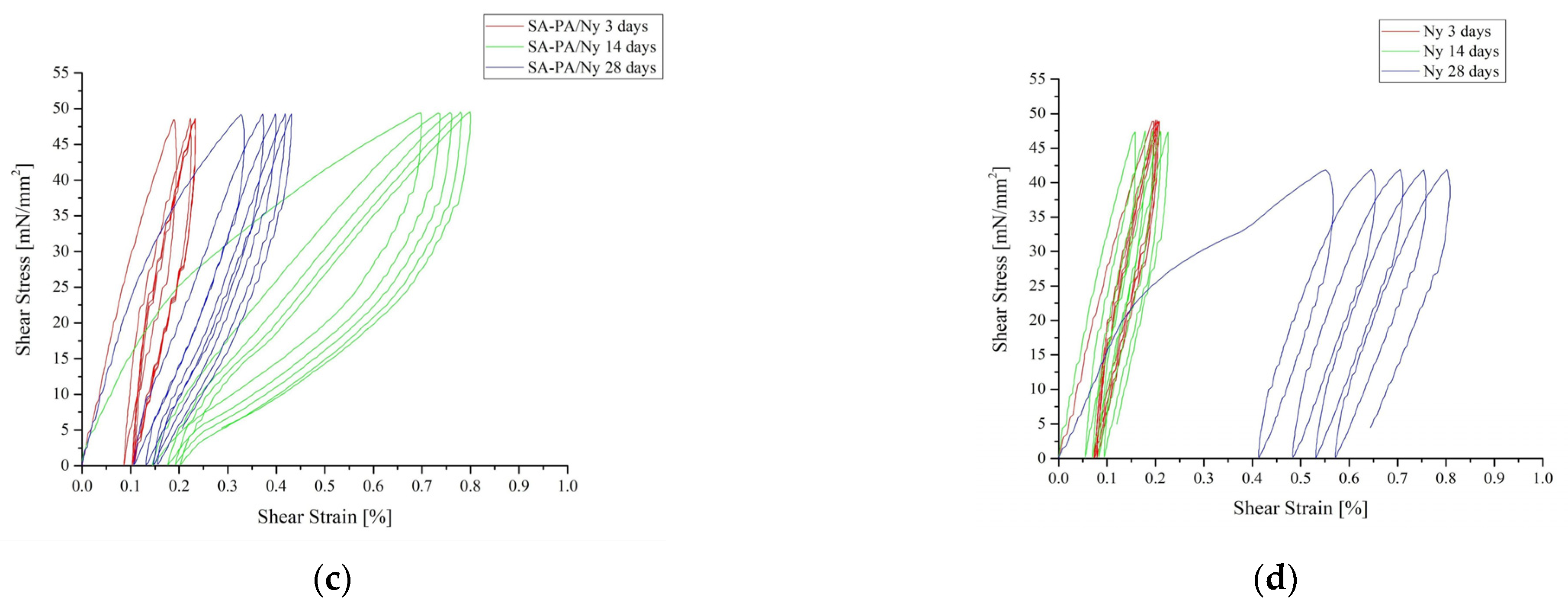
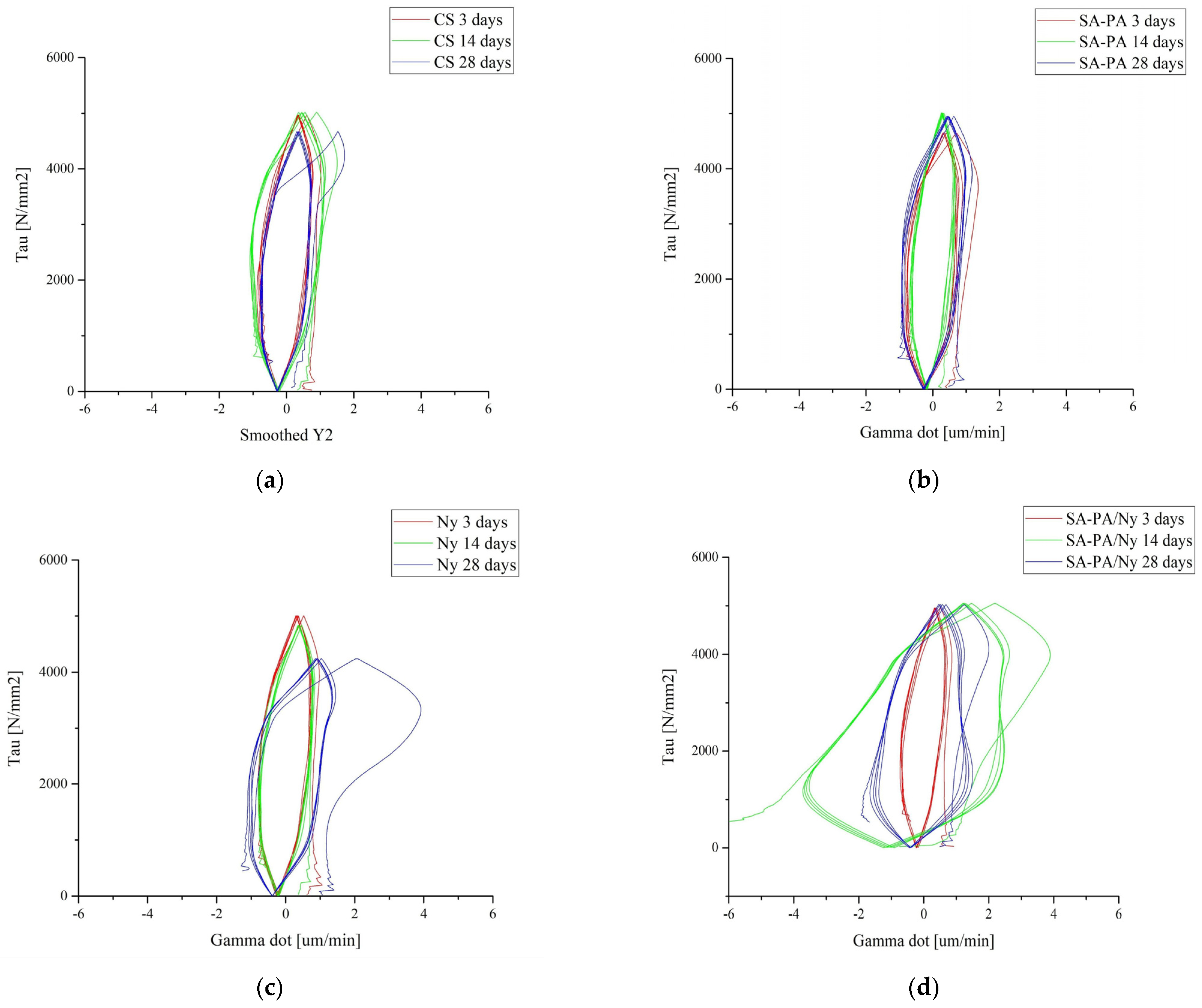
| Sample | Powder % | Water % | SA-PA % | Polyamide Fibers (Ny) % |
|---|---|---|---|---|
| CS | 71 | 29 | 0.0 | 0.0 |
| SA-PA | 71 | 29 | 0.4 | 0.0 |
| NY | 69 | 29 | 0.0 | 2.3 |
| NY/SA-PA | 70 | 28 | 0.2 | 1.3 |
| Sample | Time (s) |
|---|---|
| CS | 17 ± 1 |
| SA-PA | 11 ± 1 |
| NY | 5 ± 2 |
| NY/SA-PA | 5 ± 3 |
| Sample | Total Porosity after 3 Days of Aging (%) | Total Porosity after 14 Days of Aging (%) | Total Porosity after 28 Days of Aging (%) | Total Porosity after 28 Days of Aging and after the Thermal Treatment at 200 °C for 1 h (%) | Weight Loss after 28 Days of Aging and after the Thermal Treatment at 200 °C for 1 h (%) |
|---|---|---|---|---|---|
| CS | 16 ± 2 | 19 ± 3 | 29 ± 1 | 36 ± 1 | 27 ± 1 |
| SA-PA | 18 ± 3 | 29 ± 1 | 32± 2 | 41 ± 1 | 27 ± 1 |
| NY | 24 ± 5 | 20 ± 2 | 20 ± 2 | 43 ± 1 | 28 ± 2 |
| NY/SA-PA | 17 ± 1 | 20 ± 3 | 23 ± 1 | 41 ± 2 | 26 ± 2 |
| Thermal Conductivity (k) (W/mK) | Thermal Diffusivity (a) (mm2/s) | Specific Heat (MJ/m3 K) | k/a0.5 (m−2 K−1 s0.5 W) | a0.5/k (m2 K s−0.5 W−1) | ||
|---|---|---|---|---|---|---|
| No Treatment | CS | 0.880 | 0.304 | 2.892 | 1.596∙103 | 6.267∙10−4 |
| SA-PA | 0.711 | 0.599 | 1.187 | 9.191∙102 | 1.088∙10−3 | |
| NY | 0.800 | 0.329 | 2.431 | 1.395∙103 | 7.171∙10−4 | |
| NY/SA-PA | 0.850 | 0.356 | 2.387 | 1.424∙103 | 7.022∙10−4 | |
| 200 °C (1 h) | CS | 0.394 | 0.720 | 0.547 | 4.640∙102 | 2.155∙10−3 |
| SA-PA | 0.351 | 0.314 | 1.118 | 6.258∙102 | 1.598∙10−3 | |
| NY | 0.326 | 0.352 | 0.926 | 5.491∙102 | 1.821∙10−3 | |
| NY/SA-PA | 0.341 | 0.756 | 3.918∙102 | 2.552∙10−3 |
Disclaimer/Publisher’s Note: The statements, opinions and data contained in all publications are solely those of the individual author(s) and contributor(s) and not of MDPI and/or the editor(s). MDPI and/or the editor(s) disclaim responsibility for any injury to people or property resulting from any ideas, methods, instructions or products referred to in the content. |
© 2024 by the authors. Licensee MDPI, Basel, Switzerland. This article is an open access article distributed under the terms and conditions of the Creative Commons Attribution (CC BY) license (https://creativecommons.org/licenses/by/4.0/).
Share and Cite
Di Maggio, R.; Maracchini, G.; Cotini, O.; Albatici, R. Cement Pastes with Hygroscopic Polymeric Additions for Potential Building Applications. Appl. Sci. 2024, 14, 853. https://doi.org/10.3390/app14020853
Di Maggio R, Maracchini G, Cotini O, Albatici R. Cement Pastes with Hygroscopic Polymeric Additions for Potential Building Applications. Applied Sciences. 2024; 14(2):853. https://doi.org/10.3390/app14020853
Chicago/Turabian StyleDi Maggio, Rosa, Gianluca Maracchini, Oscar Cotini, and Rossano Albatici. 2024. "Cement Pastes with Hygroscopic Polymeric Additions for Potential Building Applications" Applied Sciences 14, no. 2: 853. https://doi.org/10.3390/app14020853
APA StyleDi Maggio, R., Maracchini, G., Cotini, O., & Albatici, R. (2024). Cement Pastes with Hygroscopic Polymeric Additions for Potential Building Applications. Applied Sciences, 14(2), 853. https://doi.org/10.3390/app14020853








